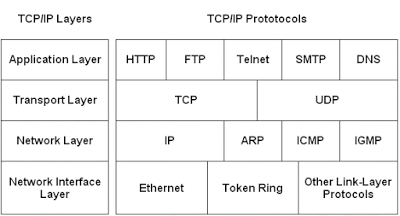What is TCP/IP protocol?
TCP/IP are not just random alphabets used to refer to a protocol suite. It is an acronym for the technical name Transmission Control Protocol/Internet Protocol. The TCP/IP is very important. Without it, no one can ever access the Internet or use anything connected to the Internet. In simple words, it’s goodbye to emails, downloading music, chatting as well as complete lock out from social media sites. Yes, without the TCP/IP protocol you cannot survive online.
Let us learn what is TCP/IP and why it is so important for anyone who wishes to be connected to the Internet.

TCP/IP – What Is It All About?
The TCP/IP is a suite of communications protocols. It helps one connect hosts to each other on the Internet. It is a two-layer program where the TCP is the higher layer and the IP is the lower layer.
The TCP assembles messages or files into smaller packets that are transmitted over the Internet. Another TCP layer that reassembles the packets into the original message receives these smaller packets.
The Internet protocol or IP takes care of the address part of each these packets. It makes sure that the packet addressed to a particular destination reaches it.
There is an extensive set of protocols make up the TCP/IP suite. It helps different computers and devices are connected over the network and share information.
TCP/IP is Standard
TCP/IP is an open-standard communications protocol suite. It is the standard mode of communication over the Internet. Whenever you get home a new computer, the TCP/IP is already stacked inside. The software stacked into your computer is always different from somebody else’s.
The Different TCP/IP Layers and Protocols
There are different layers and protocols used to send messages from your computer to another.
Some of these layers include:
- Layer 1 – Physical that includes wires, cables and radio waves
- Layer 2 – Data Link protocol works network hardware, Ethernet and VPNs
- Layer 3 – Internet is the Internet Protocol
It is further divided into:
- IPv6 (Internet Protocol Version 6)
- ARP (Address Resolution Protocol)
- RARP (Reverse Address Resolution Protocol)
- ICMP (Internet Control Message Protocol)
- IPSec (IP Security Protocols)
- L2TP (Layer 2 Tunneling Protocol)
- CIDR (Classless Inter-Domain Routing)
- Layer 4 – Transport
- TCP (Transmission Control Protocol)
- UDP (User Diagram Protocol)
- Layer 5 – Application
- DNS (Domain Name Service)
- FTP (File Transfer Protocol)
- HTTP (HyperText Transfer Protocol)
- SMTP (Simple Mail Transfer Protocol)
- POP3 (Post Office Protocol Version 3)
- Telnet, etc.
You won’t even realize the different layers and protocols your messages go through. All this happens so seamlessly. Imagine if you had to learn all the protocols and their functions to help get your messages across. It is just because of TCP/IP that using the Internet becomes a piece of cake.
References:
1.http://www.tcpipguide.com/free/t_TCPIPProtocols.htm
2.http://www.ciscopress.com/articles/article.asp?p=377101
3.http://whatismyipaddress.com/tcpip-simplified
4.http://www.webopedia.com/TERM/T/TCP_IP.html
5.http://searchnetworking.techtarget.com/definition/TCP-IP
6.http://www.computerhope.com/jargon/t/tcpip.htm